Looking at Prehistory:
Indiana's Hoosier National Forest Region, 12,000 B.C. to 1650
|

|
Looking at Prehistory:
Late Archaic Period 4,000 to 1,000 B.C.
The Late Archaic period in southern Indiana is
represented by numerous archaeological sites, including small camps and
large base camps established on a seasonal round that included nearly
every type of habitat--the swamps, creeks, rivers, uplands, and prairie
areas. A very substantial Late Archaic occupation took place within
rockshelters in the Hoosier National Forest and at many sites scattered
along the Ohio River and beyond. Shell mounds, consisting of huge
amounts of discarded shells from the freshwater mussel, accumulated at
major base camps on all the large streams and rivers along with the
bones of fish, fish hooks carved from bone, polished stone atlatl
weights, projectile points and many other tools and artifacts (Figures 48-50, 52).
Such sites as Crib Mound in Spencer County, Breeden in Harrison County,
and Bono in Lawrence County, are notable shell mound sites (Figure
51).
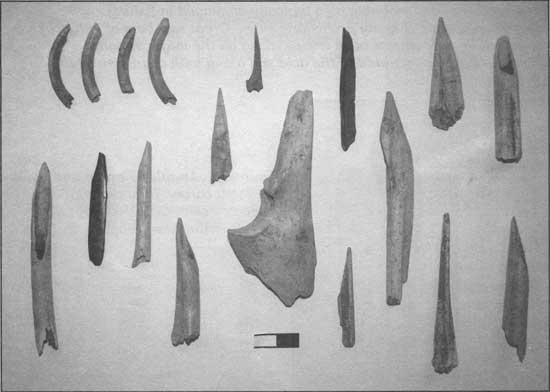
|
|
Figure 48: Prehistoric tools made from the bones of deer, fish, birds
and other animals. Many of these were used to punch holes for stitching
buckskin clothes and hide coverings, as well as weaving, basketry, and
many other uses. Rodent incisors made good wood carving tools (upper
left). The catfish spine (center) would work well almost without
modification as a needle or punch.
|
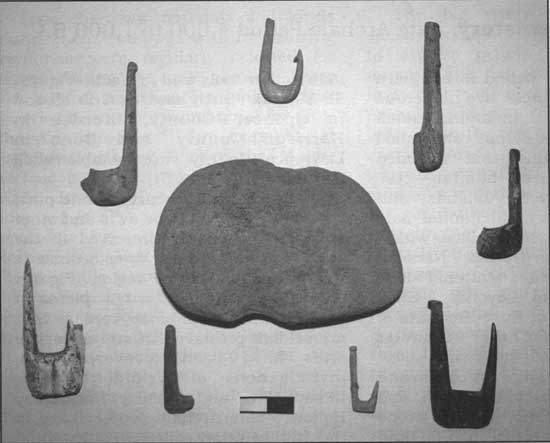
|
Figure 49: Carved bonefish hooks and a net weight from Crib Mound and
the Elrod site, Clark County, IN. While quite suitable for individual
angling, such items were probably used in multiple sets and combined in
ingenious ways with the use of nets, fish weirs and other equipment.
Depending on the time of year, the depth of the water, fishing location,
number of fisherman, and the desired catch, everything from spears to
clubs and poisons were probably also typically employed in fishing.
Bone preservation is poor at many prehistoric sites. Great numbers of
fish hooks were probably used and left at summer base camps along all
the major streams. Unfortunately, over time they deteriorated in the
acid soil along with countless other perishable tools and
artifacts.
|
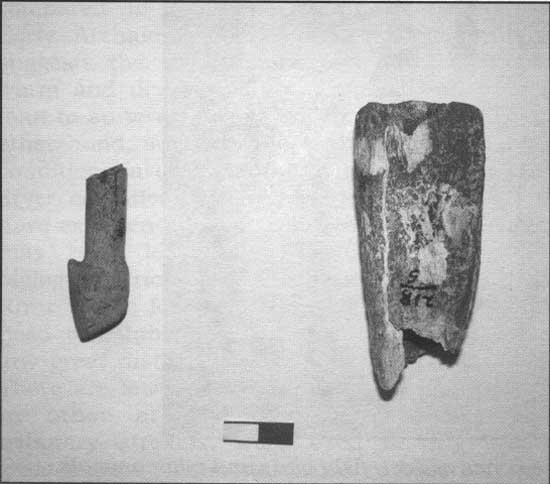
|
|
Figure 50: An atlatl handle and hook fragment carved from deer
antler recovered from Crib Mound and Clark's Point, Clark County, IN.
|
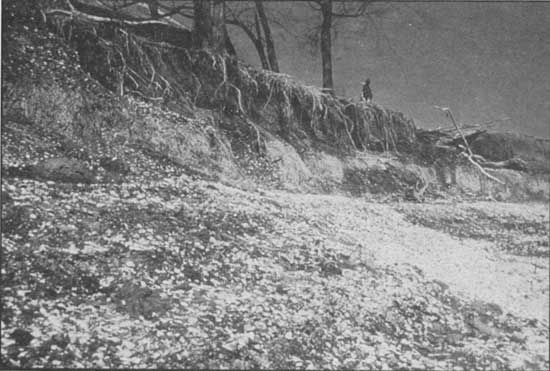
|
|
Figure 51: An early photograph of Crib Mound as it was being rapidly
eroded by the Ohio River. The millions of mussel shells discarded in
prehistory helped preserve many otherwise perishable artifacts made
from bone and antler.
|
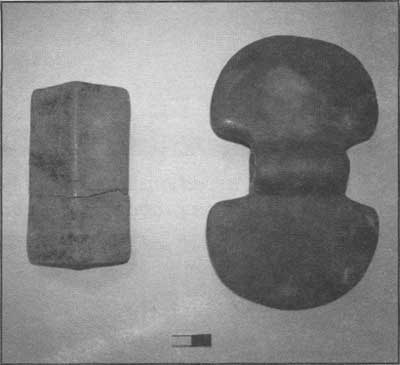
|
|
Figure 52: Middle to Late Archaic period atlatl weights of schist and
rose quartz.
|
Highly decorative carved bone pins, pendants,
gorgets, bone awls and other tools are commonly preserved in the shell
mounds and the drier sediments in the shelters of the region (Figures
53-54). In addition, a few pieces of preserved fiber and sinew cordage
that are seldom preserved in archaeological sites have been recovered
from investigations of Wyandotte Cave, Indian Cave and possibly
Rockhouse Hollow. Late Archaic people living in the hill country
collected substantial numbers of mussels along the
shoals of the Ohio and White Rivers that were sometimes carried several
miles inland from the river to be disposed of after meals in
rockshelters and other camp sites. The Bono site, for example, is
located on a bluff top and the mussels had to be carried up the steep
hillside to the site where the shellfish were eaten and the shells
discarded (Figure 55).
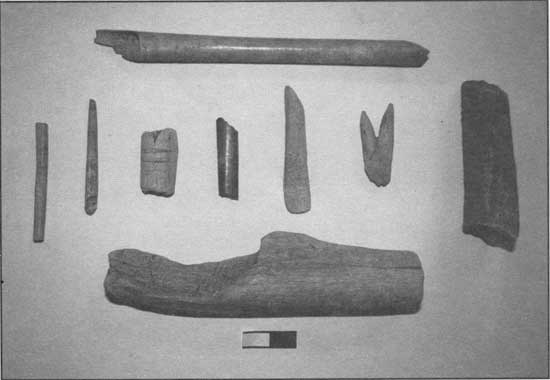
|
|
Figure 53: Archaic and Woodland period tools made from deer, bird and
other animal bones. The antler was partially sawed through with stone
tools and then snapped to extract desired pieces. Bone tools are common
in all prehistoric time periods but are found only when the soil
chemistry and environmental conditions allow bone to be preserved.
|
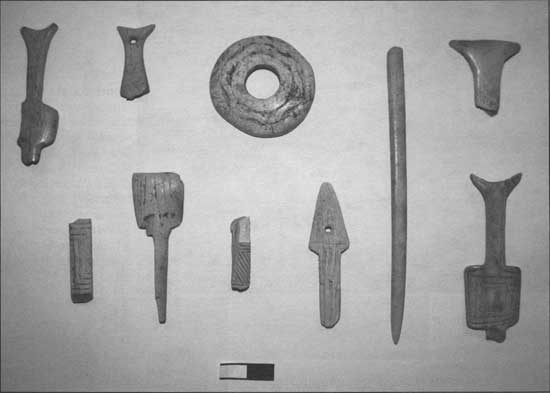
|
|
Figure 54: Carved and decorated bone pins and an
ornament from Crib Mound. The fine incising was probably done with stone
tools and sharpened rodent incisors.
|
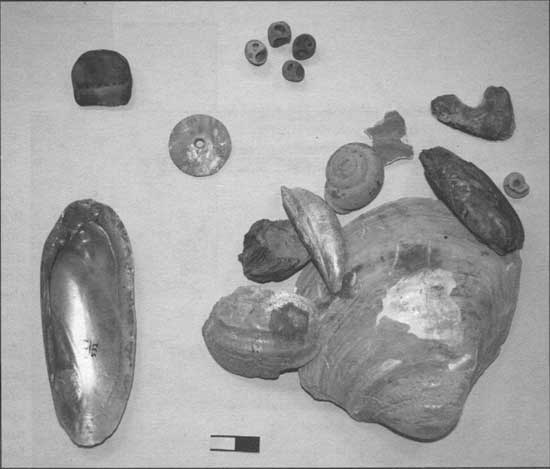
|
|
Figure 55: Fresh water mussel and snail shell from Rockhouse Hollow
Shelter, including beads and pendants made from the shell.
|
The French Lick and Maple Creek phases are local
cultural designations for the Late Archaic period in the region
centering on the Patoka Reservoir and along the Ohio River. Karnak,
McWhinney, Matanzas and Brewerton Eared
projectile points are the dominant projectile point
technologies of the time (Figure 56-57). A seasonal round was well
established. It consisted of summer and fall base camps at stream
confluences along the major rivers and fall and winter hunting camps in
rockshelters and various open sites. Matanzas appears to be a smaller
continuation of the earlier side notched tradition, whereas the others
appear to be unrelated technological developments. It remains unknown
if the Brewerton Eared technology expands down the Ohio River Valley
from the Northeastern United States or if it is only a local variation
in the same tradition that produced Matanzas within the central Ohio
Valley. There was a heavy emphasis on deer hunting and the collecting
and processing of nuts of all kinds (e.g. hickory, acorn, walnut,
butternut, chestnut), as well as starchy and oily seeds and some
horticulture at this time to boost food production.

|
|
Figure 56: Matanzas and Brewerton Eared projectile points from various
sites in the hill country. Many specimens with blunt-ends are
unifacially flaked for use as scrapers to clean and dress hides.
|
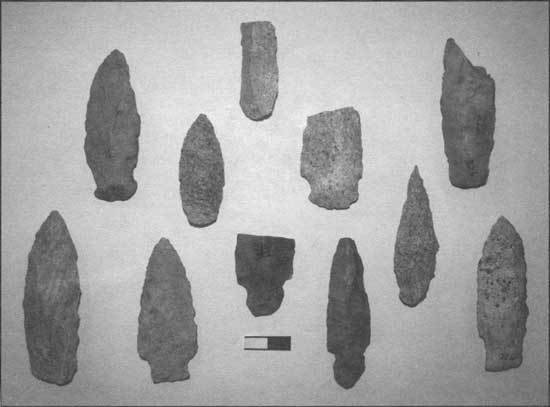
|
|
Figure 57: Late Archaic Stemmed cluster projectile points from sites in
the hill country.
|
Over-hunting of deer along the major rivers may have
been a major reason why people began using small tributary streams and
uplands over all landscapes. In addition, the problem of rapidly growing
local populations required the use of more land for hunting and
collecting to feed more families. Another reason for the widespread use
of all landscapes was the active exploration for microhabitats where
edible plants of all types grow in profusion. Besides the intensive use
of collected nuts for food, we know people all over the Midwest were
using seeds and probably greens of all types of edible plants for food
and medicine. We know this from soil samples collected from excavations
that have been washed carefully to extract small carbonized seeds and
other remains (Figure 58) and then later identified (e.g. flotation
samples). While the heavy use of nuts is indicated at this time from
many open sites and rockshelters, a fragment of
squash rind was recently recovered from Indian Cave.
This site is now added to the small list of archaeological sites in the
Midwest where this plant has been identified. Squash was utilized as
early as 5,000 B.C. and its importance as food continues to increase
until it is finally regular food grown in farms along with other wild
and domesticated plants in the Late Woodland and Mississippian
periods.
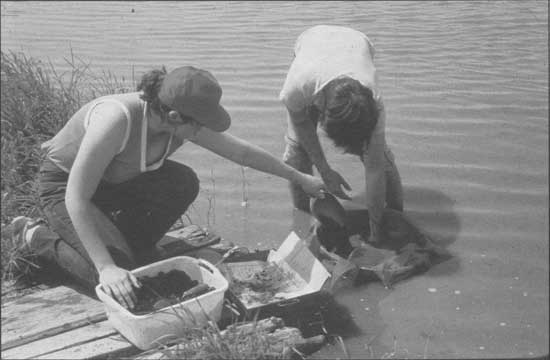
|
|
Figure 58: Soil samples recovered during an excavation are being
washed through a fine mesh (flotation) to recover charred seeds, nuts,
and wood charcoal for later identification. Indiana University field
school, 1980. Today we have specialized flotation machines that
circulate the water and make the process more efficient and also recover
more fragile charred material with less damage.
|
Evidence for the preparation of pits probably with
skin liners to boil water with hot rocks is a common theme on Late
Archaic base camps in open locations on the landscape. Base camps often
have tremendous amounts of fire cracked rocks in the middens. These
rocks fractured from the thermal shock of constantly rotating hot rocks
in and out of fires to boil water in nut filled containers. Boiling
methods presumably increased the volume and efficiency in the process of
extracting nut meat and oil from hickory nuts, acorns and other
collected nuts to make more food available. This marks an improvement in
food production, undoubtedly to feed growing families and larger groups
of people (Figures 59-60). The evidence we may have for this at many
rockshelters is mostly circumstantial, as
these sandstone alcoves naturally produced thousands of pieces of rock
fallen from the ceilings that could have been readily used for this
purpose although some pieces are reddened from burning. In any case, had
rounded river pebbles or other foreign rocks been transported to the
rockshelters, their presence would be a more obvious testimony to the
stone boiling technology at this type of site.
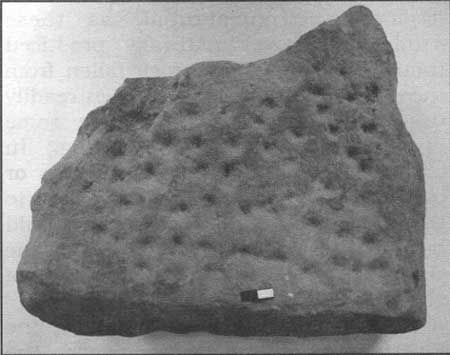
|
|
Figure 59: A large nutting stone with multiple pits to make the work
of cracking large volumes of nuts more efficient. Imagine several
families involved in transporting collected nuts in baskets back to a
seasonal camp where they would crack the nuts using several large
nutting stones and stone hammers. They would then boil, parch, and cook
the nutmeat for making breads, soups and other foods and also extract
the nut oil for various uses. Late Archaic people sought ways to make
food production more efficient and began growing and tending wild plant
foods. Creating a surplus allowed them to store prepared food for lean
times and focus on making craft items for exchange and trade with other
groups.
|
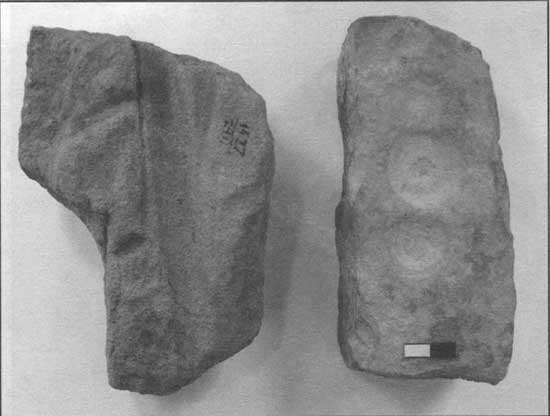
|
|
Figure 60: Sandstone abrader and nutting stone from Rockhouse
Hollow Shelter. The groove on the abrader was probably a slot where wood
and bone tools could be shaped and sharpened.
|
Toward the end of the Archaic, the Riverton and other
cultures appear. The Riverton people employed rather small side and
corner notched projectile points to arm their spears that were often
made from small chert pebbles collected from river gravel. They also
left substantial middens of dark organic soil at their base camps
testifying to the intensity at which they harvested and processed a wide
range of animals and plant foods. The Riverton people, along with other
cultural groups, are recognized mainly by the projectile point types
they produced such as Buck Creek Barbed, Turkey-tail, and Ledbetter,
etc. These peoples occupied all areas of southern Indiana
including the hill country of the Hoosier National Forest (Figure
61).
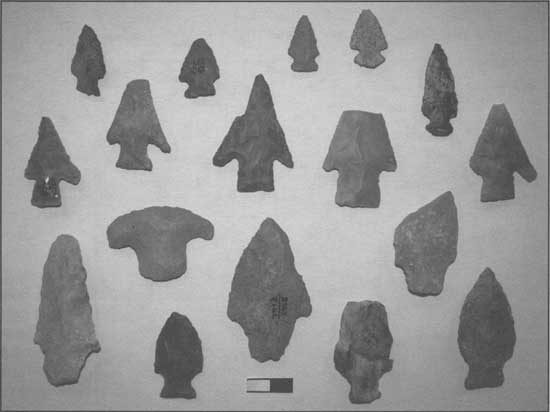
|
|
Figure 61: Late Archaic period projectile points
including Table Rock cluster, Ledbetter, Buck Creek Barbed, and
Riverton cluster types from bottom to top.
|
Beginning about 2,500 B.C. the Late Archaic period in
the Midwest is marked by long distance trade in copper, marine shell and
other items coming from the Great Lakes and Gulf Coast areas. Although
located nearly midway between these source regions, none of the sites
within the Hoosier National Forest show evidence of being the final
destinations for exotic trade goods, but people in the area probably had
a direct involvement in the trade nonetheless. Copper came mostly in the
form of beads, bracelets and awls, and less often in lumps of raw copper
(Figure 62). Marine shell was often made into beads and other decorative
items such as gorgets. Many other kinds of perishable goods could have
been used for exchange and payment for moving marine shell, copper, and
other articles through tribal territories to destinations many miles
away. The perishable goods no longer survive as testimony to the vast
exchange network in commodities that
must have existed. Some of the trade routes probably
utilized the ridge tops for easier movement north to south through the
hill country.
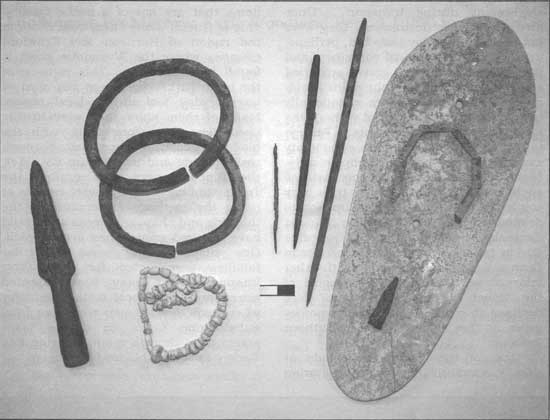
|
|
Figure 62: Copper and shell artifacts. The large shell item is a
"sandal-sole" gorget. The copper spear on the left is typical of the
Lake Superior region where the copper was mined. Such items, if they
were traded south, may have been reformed into beads, awls, and
bracelets because few, if any, spears of this type have been found
outside of the Great Lakes area.
|
One important trade commodity which was made at the
Wyandotte chert quarries near Corydon was the Turkey-tail point (Figure
63). Many large sites in the vicinity of Harrison County show intensive
industries were active producing numerous thin and finely crafted
Turkey-tails for use in a vast trade that distributed them into Ohio,
Illinois, Michigan, Wisconsin and Ontario. These are called Turkey-tail
"caches" that consisted of several to many fine specimens that were kept
together as a group. Excavations of Turkey-tail caches often show the
specimens were nested together, suggesting they were bundled for
safekeeping during transport. Once arriving at their
destination, they were not used for everyday tools but, perhaps, kept
within their original containers and soon placed in honored graves or
buried as offerings to deities in the spirit world. Some of these caches
were intentionally broken at the time of burial without the loss of any
of the fragments. Turkey-tails were probably a main commodity exchanged
for copper lumps, awls, beads and bracelets. Copper articles such as
these were making their way south from mines on Lake Superior to
destinations to the south in Illinois, Kentucky, and Indiana. One fine
Turkey-tail cache is recorded for a site in Orange County which, along
with other information, suggests at least some of the finest Turkey-tail
caches were destined to be used in local ceremonies never to be traded
out of southern Indiana.
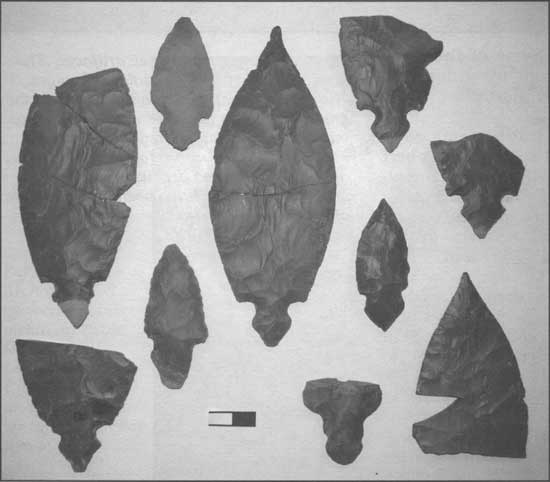
|
|
Figure 63: Turkey-tails from sites in the hill
country. The larger specimens are reconstructed from fragments surface
collected over many years from a site in Orange County that were donated
to the Glenn A. Black Laboratory of Archaeology.
|
Most of the Turkey-tails made at sites in southern
Indiana are utilitarian items that are not of a cache quality. This is true
at many sites, even those in the region of Harrison and Crawford
counties where the Wyandotte chert is found in abundance. This is
because the basic Turkey-tail shape was used as an everyday tool in the
local region. Many of them show they were heavily used like other stone
tools, with the blades becoming shortened through resharpening and use
(Figure 63). Yet, the flint-knappers who crafted the Turkey-tail cache
blades were experts at using the methods for controlling the thinning
and shaping process and would have required greater than average skill.
One suspects that some particular families were noted for their flint
knappers, who may have adopted something like a local cottage industry
where expert craftsmen were free from subsistence tasks to devote large
amounts of time to manufacturing fine Turkey-tail cache blades for
trade.
9/hoosier/prehistory/sec4.htm
Last Updated: 21-Nov-2008 |
|
















